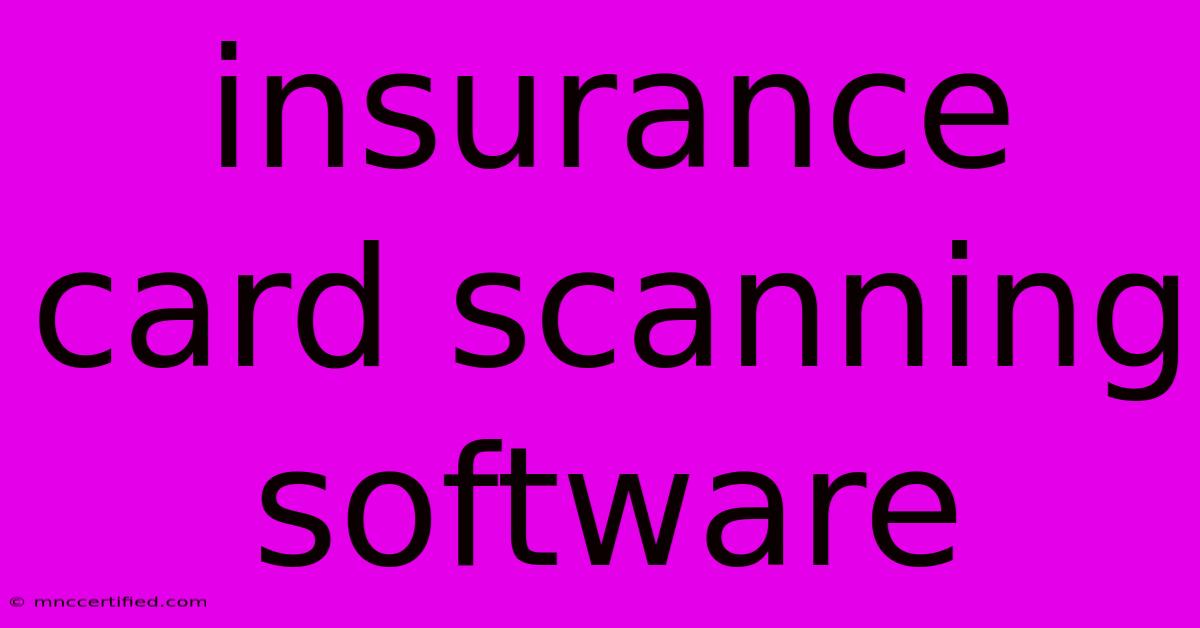Insurance Card Scanning Software

Table of Contents
Streamline Your Workflow: The Ultimate Guide to Insurance Card Scanning Software
In today's fast-paced healthcare environment, efficiency is paramount. Long gone are the days of manually entering insurance information. Insurance card scanning software offers a streamlined solution, saving time, reducing errors, and improving patient experience. This comprehensive guide explores the benefits, features, and selection process for the best insurance card scanning software for your needs.
Why Choose Insurance Card Scanning Software?
Manually entering insurance information is tedious, prone to errors, and a significant drain on resources. Insurance card scanning software offers a compelling alternative, boasting numerous advantages:
- Increased Efficiency: Automated data entry significantly speeds up the check-in process, allowing staff to focus on patient care.
- Reduced Errors: Optical Character Recognition (OCR) technology minimizes human error associated with manual data entry, ensuring accuracy.
- Improved Patient Experience: Faster check-in times lead to happier patients, enhancing the overall practice experience.
- Enhanced Security: Secure storage and compliance with HIPAA regulations protect sensitive patient information.
- Cost Savings: Reduced administrative overhead translates to significant cost savings in the long run.
- Better Data Management: Centralized databases improve data organization and retrieval.
- Integration Capabilities: Many solutions integrate with Electronic Health Records (EHR) and Practice Management (PM) systems.
Key Features to Look For in Insurance Card Scanning Software
Choosing the right software depends on your specific needs. Consider these essential features:
- OCR Accuracy: High accuracy rates are crucial for minimizing manual corrections and ensuring data integrity. Look for software with a proven track record of accuracy.
- Image Quality: The software should be able to handle various image qualities, including blurry or slightly damaged cards.
- Data Security and Compliance: Ensure the software complies with HIPAA regulations and offers robust security features to protect sensitive patient data. Look for features like encryption and audit trails.
- Integration Capabilities: Seamless integration with your existing EHR and PM systems is vital for a streamlined workflow. Check for compatibility with popular systems.
- User-Friendliness: Intuitive software is easy to learn and use, minimizing training time and improving user adoption.
- Support and Training: Reliable customer support and comprehensive training resources are essential for a smooth implementation.
- Scalability: Choose software that can scale with your practice's growth, accommodating increasing patient volumes.
- Mobile Accessibility: The ability to scan insurance cards on mobile devices enhances flexibility and convenience.
Different Types of Insurance Card Scanning Software
The market offers various types of insurance card scanning software, each with its own strengths:
- Standalone Software: These programs function independently and are ideal for practices without existing EHR or PM systems.
- Integrated Software: These solutions integrate directly with existing EHR and PM systems, streamlining workflows.
- Cloud-Based Software: Cloud-based options offer accessibility from anywhere with an internet connection, promoting collaboration.
- On-Premise Software: This type of software resides on your practice's servers, offering greater control but requiring on-site maintenance.
Selecting the Right Insurance Card Scanning Software: A Step-by-Step Guide
- Assess your needs: Determine your practice's specific requirements, including patient volume, integration needs, and budget.
- Research potential vendors: Explore different software options and compare their features, pricing, and reviews. Check out online reviews and compare different vendor offerings. Consider attending industry conferences or webinars.
- Request demos: Request demos from shortlisted vendors to test the software and evaluate its user-friendliness.
- Check for security and compliance: Ensure the software complies with HIPAA regulations and offers robust security measures.
- Consider integration capabilities: Verify seamless integration with your existing EHR and PM systems.
- Negotiate pricing and terms: Discuss pricing, contract terms, and support options with the vendor.
- Implement and train staff: Provide thorough training to your staff on the new software.
Conclusion: Embrace Efficiency with Insurance Card Scanning Software
Implementing insurance card scanning software is a strategic investment that boosts efficiency, reduces errors, enhances patient experience, and saves your practice time and money. By carefully evaluating your needs and selecting the right software, you can significantly improve your workflow and focus on providing high-quality patient care. Remember to consider factors like OCR accuracy, security, integration capabilities, and user-friendliness when making your decision. The right software can transform your administrative processes, freeing up valuable resources and enhancing your overall practice efficiency.

Thank you for visiting our website wich cover about Insurance Card Scanning Software. We hope the information provided has been useful to you. Feel free to contact us if you have any questions or need further assistance. See you next time and dont miss to bookmark.
Featured Posts
-
Steelers Vs Browns Tnf Prediction And Odds
Nov 22, 2024
-
Insurance For Inflatable Rentals
Nov 22, 2024
-
Best Oura Ring Black Friday Sales
Nov 22, 2024
-
Whole Life Insurance Farm Bureau
Nov 22, 2024
-
Affidavit Of No Excess Insurance
Nov 22, 2024